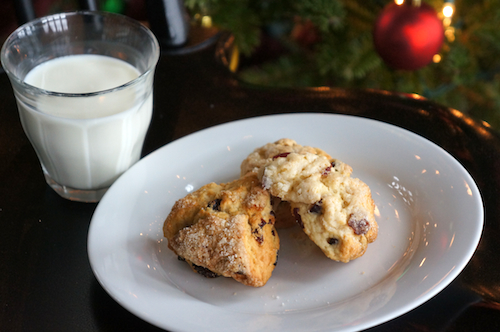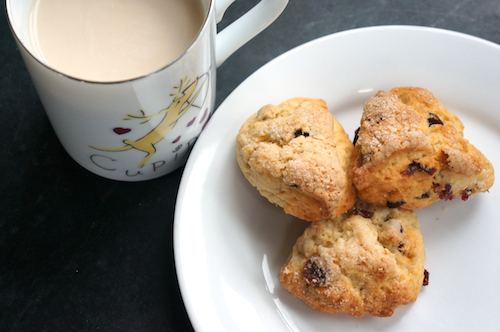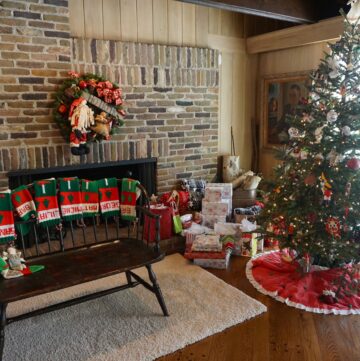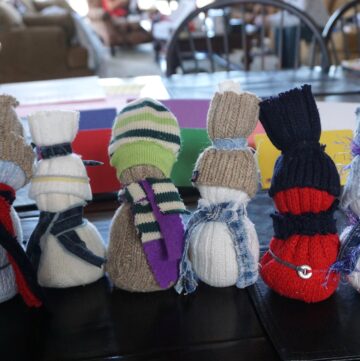It shouldn’t come as a surprise, but after making 400 scones for teachers and neighbors in the last two days, I’ve realized something important: more cream is better. Turns out it’s much safer to start with a moister dough and add flour as needed than risk a dry scone. The magic of these cream scones – all cream, no butter! – is that they melt in your mouth.
Or should. My mega-batches were coming out a bit dry, and I realized that Marion Cunningham’s brilliantly easy recipe (from her great The Breakfast Book) leaves little room for error.
For years I’d made a version of Marion’s recipe that came from my friend Lisa‘s cousin Bessie. It wasn’t until happened to flip open The Breakfast Book in a used bookstore to the exact page of the dried fruit cream scones that I learned the origin of the recipe. Later I realized that Bessie’s variation had 1/4 cup more cream than Marion’s. I thought maybe it was a typo from the many hand-offs of the recipe.
In my original dried fruit cream scones post, I tested Marion’s original recipe against Bessie’s variation. Bessie’s always made a sticky dough that required additional flour for kneading. When I used Marion’s recipe, the dough was perfect as soon as I’d incorporated in all the flour. So I posted Marion’s original recipe here.
But some flours are thirstier than others – depending on type and age of flour, humidity, time of year – and if you don’t have more cream to add, you’ll end up with a dry scone instead a moist and tender one. Since the average cook is more likely to have extra flour than extra cream on hand, I think it’s safer to start with Bessie’s recipe. That way you can add more flour as you need it.
The trade-off is that with the softer dough Bessie’s scones don’t always keep their shape, sometimes spreading a bit during cooking. But the soft, moist interior is easily worth the cosmetic sacrifice.
I’ve updated the original post and the printable version. And because I like things neat, this summer I did the math and added proportions to the recipe notes for using a full pint or quart of cream instead of the 1 1/2 cups called for in the recipe. I’ve adjusted those for Bessie’s variation.
I also added weight measurements for the flour for anyone outside of the US or using alternative flours.
Leave some scones out for Santa on Christmas Eve, or have some yourself with a cup of something hot for a treat on Christmas morning.
Other holiday recipes
- Egg, cheese and sausage strata
- 90-minute cinnamon rolls
- Gingerbread cake
- Candied walnuts
- Hot fudge sauce
- Pumpkin applesauce cake
Dried Fruit Cream Scones
Adapted from The Breakfast Book by the great Marion Cunningham. The best scones you’ve ever had. Moist, tender and a breeze to make.
Ingredients
- 2 cups flour (270g/9.5 oz), plus additional flour for kneading
- 1/4 cup sugar
- 1 tablespoon (3 teaspoons) baking powder
- 1/2 teaspoon salt
- 1/2 cup dried cranberries or other dried fruit (chopped if large)
- 1/4 cup golden raisins
- 1 1/2 cups heavy cream
Sugar topping
- Cream or melted butter for brushing on scones
- 2 tablespoons sugar (raw/coarse sugar gives a nice crunch if you have it)
Directions
- Preheat oven to 375 degrees F.
- Combine flour, sugar, baking powder and salt in a large mixing bowl. Mix with a fork.
- Add cranberries and raisins. Mix.
- Pour in cream (but keep the measuring cup for later) and mix with fork until dough becomes thick and hard to stir.
- Using hand, knead the sticky dough in the bowl, turning and pressing the dough to incorporate the flour. Add more flour if you need it, a tablespoon at a time, until surface of dough is smooth, soft and no longer sticky.
- Split the ball in half to form two smaller balls. Then split each half again in two smaller balls. You will now have four small balls of dough.
- On a lightly floured surface, slightly flatten each ball into a thick disc about 5″ in diameter.
- Pour a few drops of cream from the empty measuring cup on each disc and use fingers to spread cream evenly over the top. Sprinkle with sugar.

- Cut each disc evenly into six wedges. Place on ungreased baking sheet, leaving some room in between for scones to rise as they bake.
- Bake 15 minutes, or until scones are golden brown.
Makes 24 small scones.
Notes
- Substitute any dried fruit or nuts you like. Chop nuts and large fruit, eg dried apricots.
- I don’t recommend substituting fresh fruit for dried – I’ve tried making these with frozen blueberries, and oddly enough the water moisture of the fresh fruit dilutes the creamy moistness of this scone dough. The frozen blueberry scones were good, but the dried fruit scones are life changing.
- If you want to use a pint (2 cups) of cream, here are the other proportions: 2 2/3 cups flour, 4 teaspoons baking powder, 2/3 teaspoon salt, 1/3 cup sugar, 2/3 cup cranberries, 1/3 cup golden raisins, 2 cups heavy cream. Divide into six balls. Makes 36 small scones.
- If you want to use a quart (4 cups) of cream, here are the other proportions: 5 1/3 cups flour, 8 teaspoons baking powder, 1 1/3 teaspoons salt, 2/3 cup sugar, 1 1/3 cup cranberries, 2/3 cup golden raisins, 4 cups heavy cream. Divide into 12 balls. Makes 72 small scones.
Here’s the link to a printable version.







Wow, these scones look delicious. I have to agree that more cream almost always equals a great result. Yum!
love your recipes. However, 1-1/2 cups cream in a creamy scones pretty much negates these from the vegan category!
ha, frances, do i have that marked as vegan?? the danger of working late at night. =P fixing now, thanks so much for the heads up!
Your recipe has become my “go to” recipe for scones…and when I omit the raisins/cranberries, cut down a smidge on sugar, and use a round biscuit cutter, this has now also become my “go to” for shortcakes!
(A Smitten Kitchen recipe pointed me to this LA Times article, http://www.latimes.com/features/food/la-fo-calcookrec29a-2009apr29,0,177215.story, which in turn convinced me that the ingredient list for your scones is close enough to count as shortcake!)
hi kathleen – yes, scones, biscuits and shortcakes all have a lot in common! we also make the oatmeal shortcake recipe and eat them as scones. basically any excuse to eat these is a good one. =)
These scones were amazing. The only issue I had was that mine did not become golden brown even though I spread cream over the top per the recipe. Any ideas as to why that might have happened?
I happen to have Marion Cunningham’s book and compared the recipe in her book with your recipe. You already mentioned the difference in the amount of cream you used. Besides that, there were 2 other differences between the two recipes.
She advises to baste the top snd sides of the scones with melted butter prior to baking. Also, her scones bake at 425 F for 15 minutes as compared to your
instructions of 375 F for 15 minutes.
Do you think that those two factors would make a difference to my lavk of browning?
Thank you,
Christine
hi christine – i think temperature must be the culprit. i always cook mine at a lower temp than marion reccomends because the scones always seemed to brown too quickly at 425 degrees F. i’ve made them in multiple ovens too…maybe yours happens to run a little low? you could definitely try 425 degrees next time – just keep an eye on them for cooking time.
i’m glad they tasted great, despite the lack of color!